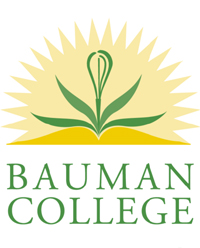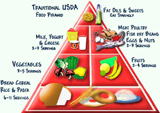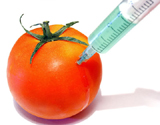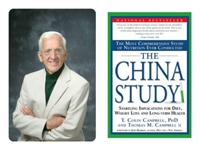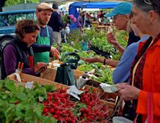Nutrition and diet
Holistic nutrition: from farm, to college, to community
Abstract
What we eat affects not only the health of an individual, but the family, community, society, and environment. The following article introduces how Dr. Edward Bauman gained his first knowledge of nutrition from owning and homesteading an organic farm. Since then, he has been studying nutrition and health systems, Eastern and Western, modern and traditional. This paved the way to create his Eating for Health approach to nutrition which became the unifying philosophy of his college. Dr. Bauman’s work articulates the benefits of eating fresh, wholesome food to the community, locally, nationally and worldwide, providing people with ways and means of eating and living well.
“Judge not each day by the harvest you reap, but by the seeds you plant.”
- Robert Louis Stevenson
My journey into holistic health and nutrition began in 1970. My friends and I bought a 160 acre organic farm in western Massachusetts and started enriching our daily lives with meditation, yoga, health studies, home-steading and community services. On the farm, I sowed my first seeds, tended my first garden, brought in my first harvest, and canned tomatoes and applesauce. In our Home Comfort Restaurant, I cooked food with produce from the farm and developed my first hands-on cooking class, From Soup to Nuts. Deeper learning about nutrition and healing came from local farmers and direct studies with Ann Wigmore, mother of raw food and wheat grass therapy; Michio Kushi, father of macrobiotics; the European naturopathic physician, Dr. Paavo Airola; herbalist, William Le Sassier; biochemist and functional medicine educator, Dr Jeffrey Bland; and Dr. Bernard Jensen, who searched the world to prove that for every ailment nature has a remedy. This journey culminated in my ability to understand the concept of holistic nutrition and write and continue to update the curriculum for the Bauman College: Holistic Nutrition and Culinary Arts.
Holistic nutrition
Holistic nutrition suggests we build our diet around whole unprocessed natural foods rather than packaged, processed food products promulgated by huge multi-national food and agriculture cartels and widely marketed as the USDA Food Pyramid, recently modified into MyPlate (1). Eating traditional, local, whole, fresh, colourful foods, grown in soil enriched with manure and compost rather than fertilizers and pesticides has been the standard of organic farming for millennia. Sadly, the current generation grew up in the midst of a culture littered with soda, frosted flakes, cheeseburgers, French fries and fake foods, major contributors to a myriad of diet, lifestyle and environment related health concerns.
Nutrition, culture and food trends
In 1989, when Bauman College started, George H.W. Bush was President and Madonna was at the top of the charts, and holistic nutrition was perceived as a quaint throwback to the days of our grandparents, a time when dinner was cooked from scratch instead of pulled out of the freezer, ready to heat n’ eat. Let’s look at changes in our food supply in the past 25 years and examine three food trends in the highly commercial Global Industrial Diet that awakened the need and interest in holistic nutrition (2).
Trend #1 — Hidden calories
US farmers now produce 3,900 calories a day more than they grew in the 1980s from corn, soy, and wheat. The food industry puts an extra 700 calories per day into people’s bodies by feeding us ready-to-eat foods made with processed corn, soybeans, vegetable oil, and high-fructose corn syrup. In the US food supply, corn contributes 554 calories a day and soy another 257. Add wheat (768 calories) and rice (91 calories) and there isn’t enough room left in the American stomach for any other foods (3). About a third of all our calories now come from junk food (4). Eating foods with more calories and less nutrients is a recipe for fatigue, diabetes, and weight gain. Conversely, whole foods, rich in the nutrients, increase our energy and endurance.
Trend #2 — vanishing plant food species
Humans have eaten some 80,000 plant species in our history. After recent changes, three-quarters of all human food come from just eight species, which now include genetically modified corn, soy, and canola (5). According to garden seed inventories, about 5,000 non-hybrid vegetable varieties were available from catalogues in 1981 and in 1998 the number went down to 600 (6). Limiting our food choices limits the kinds and amounts of nutrients available to us. It also seriously endangers our food supply in the case of pest infestations or attacks by microbes because it is the diversity of a species that enables crops to survive.
Over the past 14 years, genetically modified organisms (GMOs) have been stealthily entering our food supply. GMO seeds have added genes of other animals, bacteria, insects, and viruses. A rash of protest cites the health hazards of GMO raised corn, soy, canola oil, sugar beets and cottonseed oil. Recently, French President Francois Hollande announced that his country would maintain its ban on GMO corn. Both human and animal studies have confirmed that bio-toxins in GMOs have contributed to the rise in obesity, diabetes, dementia, allergies, autoimmune conditions, liver, and kidney disease.
Trend #3 — diet — disease connection
Today, heart disease causes at least 40 percent of all US deaths. During the sixty-year period from 1910 to 1970, the proportion of traditional animal fat in the American diet declined from 83 percent to 62 percent and butter consumption plummeted from 18 pounds per person to 4. During the same period, the percentage of dietary vegetable oils in the form of margarine, shortening, and refined oils increased to 400 percent while the consumption of sugar and processed foods increased to 60 percent (7).
An American born in 2000 has a 1 in 3 chance of developing diabetes in his lifetime; the risk is 1 in 2 for Hispanics or African Americans. A diagnosis of diabetes subtracts roughly twelve years from one’s life and living with the condition costs about $13,000 a year (8). Many diseases can be beneficially impacted by eating nutritious organic whole foods. The demand for non-GMO animal feed is growing exponentially as farmers want to prevent multiple illnesses in their livestock from GMO corn and soy feed (9).
Holistic nutrition evidence base and approaches
In 1989, the field of holistic nutrition encompassed a variety of dietary systems. Exciting research verified that food was the primary promoter of health and protector from disease. This gave the public and the medical profession a much needed wake-up call. Dr Dean Ornish published his findings in The Lancet (1990), the leading medical journal in England, that a low fat vegetarian diet combined with yoga and emotional support reversed cardiovascular disease in 84 percent of participants who followed his programme for one year (10). C. Colin Campbell of Cornell University reported the results from the large The China Study, showing that urbanites who ate a diet high in saturated fats and animal protein had higher incidence of mortality and morbidity than farm folks who ate a plant-based diet with limited amounts of animal protein (11).
For the past 25 years, diet wars have persisted as proponents jockey for market share of their books, nutrient programmes, and ideological supremacy. Conflicting evidence during this time has been confusing to consumers and health providers. Beyond the hubbub of these debates, however, is one key denominator: people need to eat more fresh whole foods and minimise their intake of processed and refined foods. Twenty years ago, I created the Eating for Health approach, which is founded on eating a variety of S.O.U.L. (seasonal, organic, unprocessed and local) foods, individually selected to meet a person’s unique constitution, condition, context, and commitment (12).
The latest breakthrough in research demonstrated that healing benefits of phyto-nutrients found in healthy whole foods, aromatic herbs, and savoury spices can cool inflammation and restore the integrity of our tissues and organs. It could explain why traditional cultures that enjoy curry, pesto, lemon grass, ginger, garlic, cinnamon, and peppermint live longer and are less dependent on modern medicine. Certified nutrition consultants and natural foods chefs, professionally trained at the Bauman College, in the non-dogmatic, person-centred, holistic approach, provide individual guidance for consumers interested in making cost-effective diet and lifestyle changes to restore balance. The Bauman Model of Holistic Nutrition affirms that food is the foundation, herbs and supplements are for special health issues, and attitude is the crown of creation and maintenance of healthy habits.
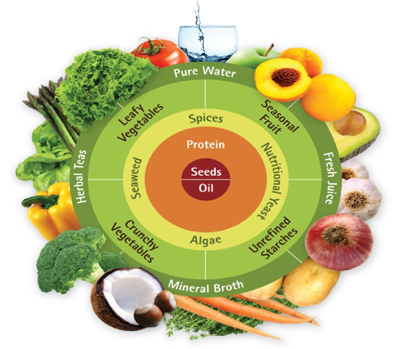
Eating for Health predated Michael Pollan’s concise and irrefutable axiom, “Eat food. Not too much. Mostly plants (13).”
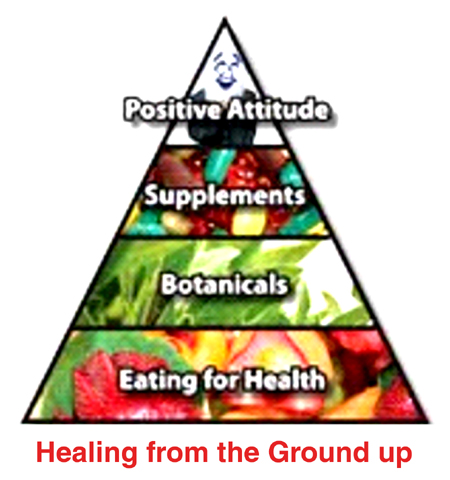
Farmers’ markets
Farmers’ markets have been the brightest stars on the holistic nutrition, whole foods, and sustainable agriculture horizon. Following the passage of the Farmer-to-Consumer Direct Marketing Act of 1976, active U.S. farmers’ markets have grown from about 350 to over 7,000 today or an average of 125 per state (14). Buying fresh food at a vibrant market with growers standing proudly behind the fruits of their labour is fun and socially uplifting as it brings people, food, culture and community together.
Organic is more nutrient-rich
The biggest study of organic food to date has found that it is more nutritious than ordinary produce and may help to lengthen people’s lives. The four-year project in England found that organic fruits and vegetables contained as much as 40% more health promoting antioxidants and minerals like iron and zinc. The researchers grew fruit and vegetables and reared cattle on adjacent organic and non-organic sites on a 725-acre farm attached to Newcastle University and at other sites in Europe. They found that levels of antioxidants in milk from organic herds were up to 90% higher than in milk from conventional herds. There were 40% more antioxidants in organic vegetables from Greece with significantly higher levels of flavonoids (15).
In 2009, a 10-year study by the University of California found that organic tomatoes had twice as much of flavonoids, antioxidants helpful to reduce the risk of heart disease (16). Other studies have shown that organic milk having higher levels of omega-3 fatty acids may boost overall health.
Different research studies may show variable results but the overall trend is that organic fruits, vegetables and milk are more likely to be higher in beneficial compounds. According to researcher, Prof. Carlo Leifert, organic produce is higher in Vitamin C, iron, copper, zinc, and antioxidants helpful to combat cancer and heart disease (17).
Advocate for holistic and sustainable nutrition
I recommend we call Michelle Obama the First Lady of holistic nutrition. She has been a tireless advocate for eating fresh fruits and vegetables, exercising regularly, and learning how to garden and cook. Recently, Michelle Obama appeared on The Tonight Show and offered the hosts her homemade kale chips. Our First Lady made a powerful statement to more than 7.7 million viewers that greens are gold (18).
Dr Rob Lustig, a noted paediatrician and expert lecturer on ‘The bitter truth about sugar’, found that one third of surveyed parents stated that they had little skill or interest in cooking and eating well at home (19). This is a far cry from traditional societies, where families eat all of their meals at home as well as source, grow, prepare and clean up after a meal together.
The astounding success of whole foods markets around the country demonstrates a powerful consumer interest in organic food and healthfully prepared food and meals. Consumers want reasonably priced, local, seasonal and fresh foods. It has led to a burgeoning interest in organic farms, backyard gardens, slow foods, healthy takeout food, cooking shows, and cooking classes. This collective buying power is opening the way for fast-food restaurants, such as Wendy’s, to serve fresh, never frozen burgers and salads.
Local food saves money and leaves a lighter carbon footprint than conventional food shipped 1,500 miles to a supermarket. Holistic nutrition becomes Sustainable Nutrition TM when people make healthy diet and lifestyle choices that are healthy for ecology and economy. Shopping for value rather than price and convenience shows a higher level of awareness and responsibility. By saying ’no’ to GMOs we are supporting a cycle of health rather than a cycle of disease (see flowcharts). ‘Let food be thy medicine and medicine be thy food’– what Hippocrates said many centuries ago is even more true now than ever.
Nutrition in action: Rethinking School Lunch
Public schools in California and across the world are implementing nutrition and physical activity programmes. In 2012, the schools in Oakland received $44 million in bond funds for food-related facilities and programmes like a new central kitchen, education centre, and 1.5-acre campus farm (20). Advocacy for healthy, freshly prepared school meals is strong all over the country. In 2013, a nationwide research conducted by Kaiser Permanente (21) revealed:
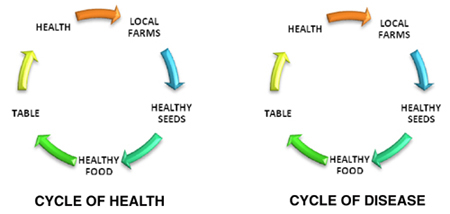
• 64% of adults think schools should take a major role in reducing obesity.
• 78% agree healthier school meals affect academic performance.
• 88% favour new standards of healthy meals and beverages.
The goal is to improve school food, teach nutrition, support sustainable food systems and create an education programme focusing on understanding the relationships between food, health, culture, and environment. Let’s look at the numbers:
• 4,000 – number of school meals a student might eat between kindergarten and 12th grade.
• 5,500,000,000 – number of school lunches served annually in the US.
What a difference it would make for the brain development and life experience of a child who eats 4,000 fresh, healthy meals made from fresh vegetables and fruits, nuts and seeds, gluten free grains, clean fats, and lean proteins instead of burgers, fries, pizza, soda, chips, ice cream and cookies.
The vision
Rethinking School Lunch is a farm-to-school framework based on the positive vision of improving nutritional value and quality of school food, connecting students to food sources through meals and field trips and supporting local farmers and sustainable agriculture. It integrates students’ experiences of gardening, cooking, teaching, and learning and emphasises understanding the connections between food, personal and community health and the natural world (22).
Real vs. manufactured taste
Eating for Health is a food model that is timeless, essential and full of integrity. It’s qualitatively different from the Global Food Diet which is prevalent, dangerous, and contributes to the current health apocalypse. A journey to health begins by eating fresh, seasonal meals away from the noise of a television or looking at a computer screen. Tasting the flavours of a homemade meal prepared from the fruits of the earth awakens an innate knowledge that real food is most enjoyable and nourishing to body and soul. In comparison, processed food lacks vital energy and nutrients to protect us from the insults of a polluted environment and stressful lifestyle.
Culturally, the tipping point is near as this message reaches the mainstream: that healthy seeds grown in healthy soil produce healthy plants that provide healthy food for micro-organisms, animals, and humans. Once well-fed and in harmony with nature, humans will align with their highest Selves, enjoy well-being, stop fighting and support others to live holistically, harmoniously, and healthfully ever after.
References
1. USDA. Choose MyPlate. [Online] Available from: http://www.choosemyplate.gov/videos.html [Accessed 6th March 2014].
2. Lustig, R. The Fat Chance Cookbook. New York: Hudson Street Press; 2013, p. 10.
3. PollanM. The Omnivore’s Dilemma: A Natural History of Four Meals. New York: Penguin; 2007. p. 117.
4. Kingsolver B, Kingsolver C, Hopp S. Animal, Vegetable, Miracle: A Year of Food Life (P.S.). New York: Harper Collins; 2008, p. 14.
5. Ibid., p.49.
6. Ibid., p. 52.
7. Fallon S. Nourishing Traditions: The Cookbook that Challenges Politically Correct Nutrition and the Diet Dictocrats. Washington, D.C.: New Trends; 1999, p. 5.
8. Pollan M. The Omnivore’s Dilemma: A Natural History of Four Meals. New York: Penguin; 2007, p. 136.
9. Organic and Non-GMO Report, 2013. [Online] Available from: http://www.non-gmore port.com/[Accessed 6th March 2014].
10. Ornish D. Can You Prevent — And Reverse — CAD?, The Lancet 1990; (336):129-33.
11. Campbell TC, et al. The China Study: The Most Comprehensive Study of Nutrition Ever Conducted and the Startling Implications for Diet, Weight Loss and Long-term Health. Dallas: BenBella; 2006, p. 150.
12. Bauman E, Friedlander J. Foundation of Nutrition. Penngrove: Bauman College; 2011, p. 4.
13. Pollan, M. The Omnivore’s Dilemma: A Natural History of Four Meals. New York: Penguin; 2007, p. 117.
14. USDA. National Count of Farmer’s Markets Directory Listing Graph: 1994-2013. [Online] Available from: http://www.ams.usda.gov /AMSv1.0/ams.fetch TemplateData.do? template=TemplateS & leftNav=Whole saleand FarmersMarkets & page=WFM Farmers Market Growth&description= Farmers%20 Market %20Growth [Accessed 6th March 2014].
15. Sample I. Organic Food is Healthier: Study. The Guardian. [Online] Available from: http://www.theguardian.com/science/2007/oct/29/organics.sciencenews [Accessed 6th March 2014].
16. Mitchell AE, Hong YJ Hoh E, et al. Ten-year comparison of the influence of organic and conventional crop management practices on the content of flavonoids in tomatoes. J Agric Food Chem 2007; 55: 6154-9.
17. Sample I. Organic Food is Healthier: Study. The Guardian. [Online] Available from: http://www.theguardian.com/science/2007/oct/29/organics.sciencenews [Accessed 6th March 2014].
18. Fallon J, Ferrel W. The Tonight Show with Michelle Obama. “Ew!” [Online] Available from: http://www.youtube.com/watch? v=HOK4aBYNh3s [Accessed 6th March 2014].
19. Lustig R. The Fat Chance Cookbook. New York: Hudson Street Press; 2013, p. 24.
20. Lewis M. Join CFPA in supporting Oakland’s Measure J. California Food Policy Advocates. [Online] Available from: http://cfpa.net/childnutrition/childnutritionschoolbreakfast /join-cfpa-in-supporting-oaklands-measure-j [Accessed 6th March 2014].
21. Field Research Corporation. Childhood Obesity Prevention Survey. 2013. [Online] Available from: http://xnet.kp.org/newscenter/pressreleases/nat/2013/downloads/2013-KP-Childhood-Obesity-Prevention-Survey-Findings.pdf [Accessed 6th March 2014].
22. Center for Ecoliteracy. Rethinking School Lunch Guide. Oakland, CA. 2014 [Online] Available from: http://www.ecoliteracy.org/down loads/rethinking-school-lunch-guide [Accessed 6th March 2014].
21. Field Research Corporation. Childhood Obesity Prevention Survey. 2013. [Online] Available from: http://xnet.kp.org/newscenter/pressreleases/nat/2013/downloads/2013-KP-Childhood-Obesity-Prevention-Survey-Findings.pdf [Accessed 6th March 2014].
22. Center for Ecoliteracy. Rethinking School Lunch Guide. Oakland, CA. 2014 [Online] Available from: http://www.ecoliteracy.org/down loads/rethinking-school-lunch-guide [Accessed 6th March 2014].
Dr. Edward Bauman is the owner of the Bauman College: Holistic Nutrition and Culinary Arts, California, USA.
Share with us (Comments,contributions,opinions)
When reproducing this feature, please credit NAMAH,and give the byline. Please send us cuttings.

